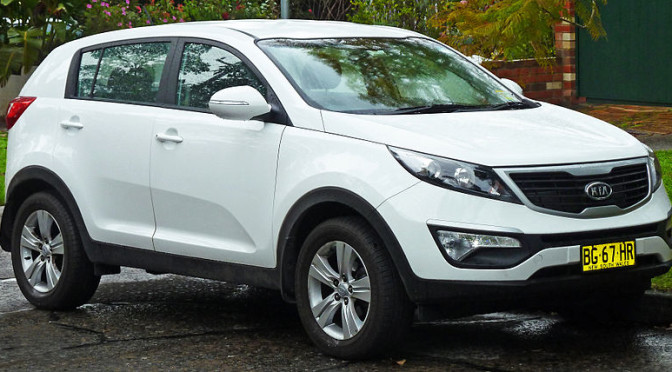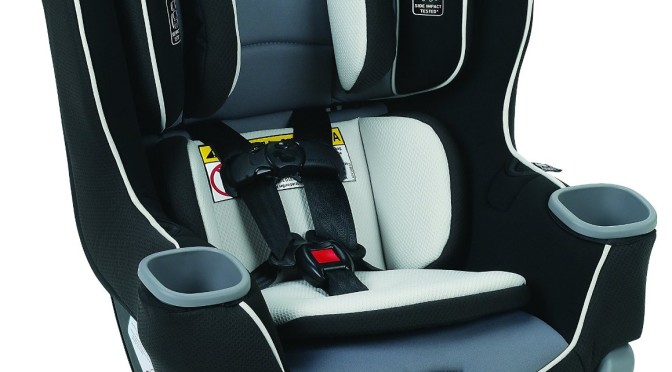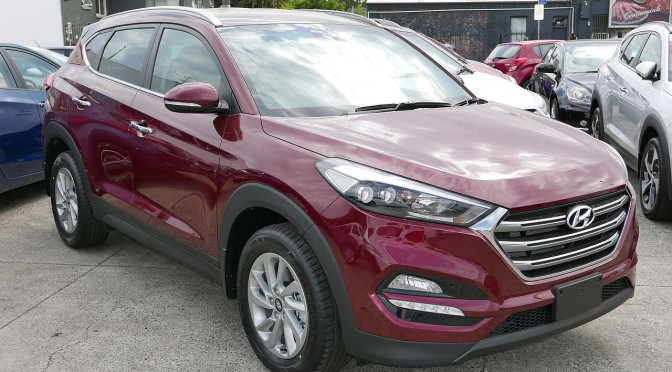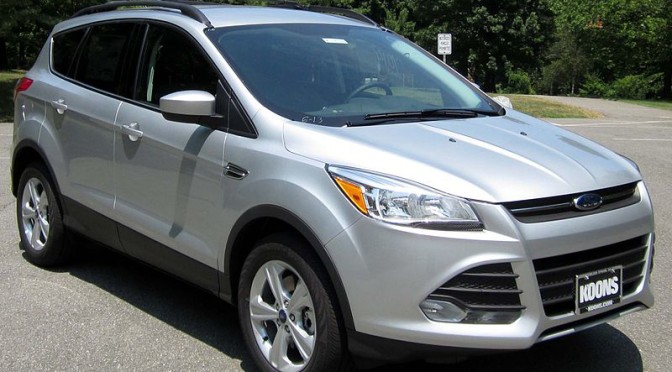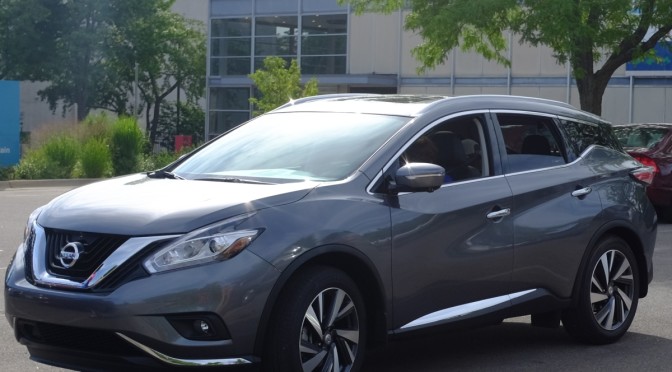The Kia Sportage is one of the least expensive small SUV-style crossovers you can buy today in the United States. It competes with a range of more expensive alternatives like the Honda CR-V, Toyota RAV4, Nissan Rogue, Mazda CX-5, Subaru Forester, Ford Escape, Jeep Compass, and Jeep Patriot. The modern Sportage is equipped with several notable safety features, including good moderate overlap front and side impact scores, a good roof strength score, and side airbags and electronic stability control, or ESC. However, the Sportage continues to be dogged by a poor small overlap score, which Kia will need to address in the redesign of the Sportage, and soon.
That said, the Sportage is still frequently chosen by families interested in an SUV or crossover-type vehicle in a short and nimble package, which meant I was interested in finding out how friendly of a vehicle it would be in terms of 3 across car seat installations.
The bad news is that there’s not very much room for car seats in terms of front-to-back space in any generation of the Sportage. The good news is that it’s a surprisingly wide crossover that’ll give you plenty of options for 3 across installations in terms of width. Before going into the details, here are some suggestions about when to use various types of car seats, whether you’re driving a Sportage or behind the wheel of any other kind of vehicle.
The safest configuration we know of when it comes to vehicle safety is rear-facing. This goes for adults as well! Rear-face your infants, toddlers, and preschoolers for as long as possible (ideally until 4!), before forward-facing them in harnessed convertible or combination seats (ideally until 8!). Once they outgrow their harnessed seats, it’s best to keep them restrained in high-back boosters until they’re physically and psychologically ready to use adult seat belt systems (which typically happens between 10 and 12). We want our little ones in the safest positions we know of for as long as possible to give them the greatest advantages in a collision.
Keeping these ideas in mind, I set to work to find which infant, convertible, combination, and booster seats would work best in 3 across combinations in the Kia Sportage. It’s my goal to make this list the most thorough on the Internet. If you find the list helpful when shopping for car seats, you can shop through my Amazon link below. I’ll add more seats as I test them over time.
You can access the complete 3 across guide for every vehicle here and the complete list of recommended seats here. The Canadian car seat guide is here. 3 across car seat images are courtesy of Wikipedia.
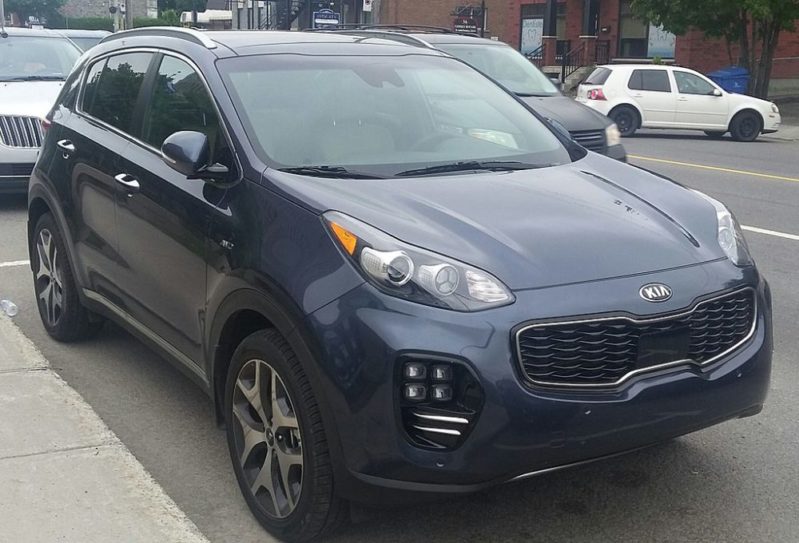 2017 Kia Sportage (QL)
2017 Kia Sportage (QL)
Guaranteed 3 across installations:
Clek Fllo (x3).
Clek Foonf (x3).
Diono Radian RXT (x3).
Diono Radian R120 (x3).
Diono Radian R100 (x3).
Combi Coccoro (x3).
Clek Fllo, Diono Radian / RXT, Diono Radian / RXT.
Clek Fllo, Graco Size4Me 65, Diono Radian / RXT.
Chicco KeyFit 30, Clek Fllo, Chicco KeyFit 30.
Tips and Tricks:
The current generation of the Kia Sportage is just over 176 inches long and 73 inches wide. As with prior generations, the length means you’re going to struggle with front-to-back space with a lot of the car seats you install if you’ve got taller drivers or longer car seats; you’ll want to check out the guide to short convertibles if you’ve already got a seat that you’d like to compare to the ones on this list. That said, the good news is that at 73 inches across, the Sportage is as wide as a number of mid-sized SUVs, and will offer a decent number of options when it’s time for 3 across setups. As usual, be sure to use your seat belts instead of the LATCH system to make the most of the space you have.
As before, because of the length of the vehicle, if you want to make the most of your money, I’d strongly recommend Radians due to the minimal amount of space they take up with angle adjusters; your legs and front-row passengers will thank you.
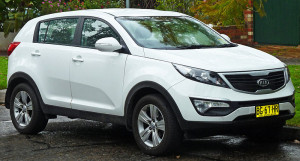 2011, 2012, 2013, 2014, 2015, 2016 Kia Sportage (SL)
2011, 2012, 2013, 2014, 2015, 2016 Kia Sportage (SL)
Guaranteed 3 across installations:
Clek Fllo (x3).
Clek Foonf (x3).
Diono Radian RXT (x3).
Diono Radian R120 (x3).
Diono Radian R100 (x3).
Combi Coccoro (x3).
Clek Fllo, Diono Radian / RXT, Diono Radian / RXT.
Clek Fllo, Graco Size4Me 65, Diono Radian / RXT.
Chicco KeyFit 30, Clek Fllo, Chicco KeyFit 30.
Tips and Tricks:
The third generation of the Kia Sportage is 175 inches long and 73 inches wide. The length means you’re going to struggle with front-to-back space with a lot of the car seats you install if you’ve got taller drivers or longer car seats; you’ll want to check out the guide to short convertibles if you’ve already got a seat that you’d like to compare to the ones on this list. That said, the good news is that at 73 inches across, the Sportage is as wide as a number of mid-sized SUVs, and will offer a decent number of options when it’s time for 3 across setups. As usual, be sure to use your seat belts instead of the LATCH system to make the most of the space you have.
Because of the length of the vehicle, if you want to make the most of your money, I’d strongly recommend Radians due to the minimal amount of space they take up with angle adjusters; your legs and front-row passengers will thank you.
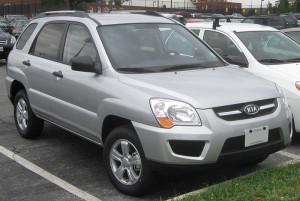 2005, 2006, 2007, 2008, 2009, 2010 Kia Sportage
2005, 2006, 2007, 2008, 2009, 2010 Kia Sportage
Guaranteed 3 across installations:
Clek Fllo (x3).
Clek Foonf (x3).
Diono Radian RXT (x3).
Diono Radian R120 (x3).
Diono Radian R100 (x3).
Combi Coccoro (x3).
Clek Fllo, Diono Radian / RXT, Diono Radian / RXT.
Clek Fllo, Graco Size4Me 65, Diono Radian / RXT.
Chicco KeyFit 30, Clek Fllo, Chicco KeyFit 30.
Tips and Tricks:
The 2005-2010 generation of the Kia Sportage is 171 inches long and 71 inches wide. Once again, the length means you’re going to struggle with front-to-back space with a lot of the car seats you install if you’ve got taller drivers or longer car seats; you’ll want to check out the guide to short convertibles if you’ve already got a seat that you’d like to compare to the ones on this list.
As usual, be sure to use your seat belts instead of the LATCH system to make the most of the space you have.
Because of the length of the vehicle, if you want to make the most of your money, I’d strongly recommend Radians due to the minimal amount of space they take up with angle adjusters; your legs and front-row passengers will thank you.
—
If you find the information on car safety, recommended car seats, and car seat reviews on this car seat blog helpful, you can shop through this Amazon link for any purchases, car seat-related or not. Canadians can shop through this link for Canadian purchases.
2016 Graco Extend2Fit Preview Review: 50 lbs Rear-Facing!
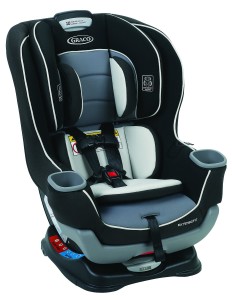 Update: Here is my review of the Graco Extend2Fit with 3 across guides.
Update: Here is my review of the Graco Extend2Fit with 3 across guides.
Every now and then a car seat manufacturer comes along that raises the bar. A couple of years ago, Clek did it by becoming the first manufacturer in the US to offer 50-lb rear-facing seats with the Foonf. The ability to rear-face children in car seats until they reached 50 pound had been available in Sweden for years, but until a few years ago, it had not been an option available to parents in the United States.
Two years ago in 2014, Diono challenged Clek by offering not one, but two 50-lb-capable rear-facing convertibles: the Rainier and the Pacifica, and offering each at a lower price than the Foonf. Clek, of course, responded soon after with the Fllo, which was cheaper and lighter than the Foonf and narrower than the Rainier and Pacifica.
Things stayed the same until 2015, when Safety 1st entered the 50-lb game this year with the Advance EX 65 Air+, which became the first 50-lb seat under around $300. It was bulkily-sized and bulkily-named, but it was more affordable. Finally, Graco has entered the 50-lb game with the soon-to-be released Graco Extend2Fit convertible, which promises 50-lbs of rear-facing goodness for under $200 MSRP. Is it too good to be true? Let’s take a look!
How long will children be able to rear- and forward-face in the Graco Extend2Fit?
Children will be able to rear-face from 4-50 lbs and forward face from 22-65 pounds. There is a 49″ height limit when forward-facing, the standard 1″ from the top of the seat rule applies when both rear- and forward-facing, and an infant insert must be used when your child is at the lower end of the weight range while rear-facing. There is a 10-position adjustable harness that tops out at 18 inches, and you can choose from 6 recline positions; 3 of which are designed for rear-facing and 3 of which are exclusive to forward-facing.
How much will the Graco Extend2Fit weigh, and what are its dimensions?
The Extend2Fit is expected to weigh around 25 pounds and is about 20″ wide from one cupholder to the next, which means you’ll still want to consider seats like the Fllo and Foonf if you’re interested in narrow seats that allow you to rear-face to 50 pounds while still working in 3 across situations. Graco states that the seat is designed to be sufficiently compact such that an average-height man will be able to use a front passenger or driver seat immediately in front of the Extend2Fit without needing to pull the vehicle seat forward excessively. I’m not sure what that translates into in daily use, but I’ll be happy to test the seat and add it to my rear-facing convertible space guide once I have it in my hands.
How long will parents be able to use the Graco Extend2Fit?
Per Graco, the Extend2Fit has a 10-year shelf life, meaning you will potentially be able to get 10 years of use out of it. Practically speaking, you’re not going to get that much time with one child, as a child who used it from birth would almost certainly outgrow the forward-facing 65-pound limit long before reaching 10 years of age. However, you’ll definitely be able to use it for at least 6 years with most children, and even longer with shorter or lighter children. And quite frankly, the best combination / booster seats on the market, the Frontier G1.1 and Pinnacle G1.1, are still going to be the best choices for getting your kids to the point where they don’t need car seats anymore.
How much will the Graco Extend2Fit cost, when’s the release date, and where can I buy it?
The Graco Extend2Fit is expected to cost $199, placing it right under the $200 barrier that’s often the most many parents can afford when it comes to car seats. You’ll be able to buy it at Amazon, and I’ll have a review ready as soon as I get my hands on one. It should be available for pre-order this December and formally ship in January 2016.
This is great news for fans of extended rear-facing and affordable car seats, and will hopefully lead to more parents taking advantage of the myriad of reasons to continue rear-facing past 1, 2, and into the preschool years.
—
If you find the information on car safety, recommended car seats, and car seat reviews on this car seat blog helpful, you can shop through this Amazon link for any purchases, car seat-related or not. Canadians can shop through this link for Canadian purchases.
3 Across Installations: Which Car Seats Fit a Hyundai Tucson?
The Hyundai Tucson is a small, cheap, and energetic SUV-style crossover sold in the United States. Currently in its third generation, it competes with luminaries in the compact crossover market like the Honda CR-V, Toyota RAV4, Nissan Rogue, Mazda CX-5, Mitsubishi Outlander, Subaru Forester, Ford Escape, Jeep Compass, Kia Sportage, Jeep Renegade, and Jeep Patriot. The Tucson, which is also known as the ix35 overseas, shares its structure with the Kia Sportage as well as with the Hyundai Elantra and Kia Forte, and is frequently cross-shopped with the aforementioned vehicles by people interested in compact, safe, and fuel efficient transportation.
I looked into the current and previous generations of the Tucson to figure out just how friendly they were when it came to the all-important task of fitting 3 car seats across the back row. Given the smaller size of the Tucson, I was expecting a challenge, but was pleased to find out a number of car seats could be made to work without too much of a struggle. Before looking in depth at which seats did and didn’t work, it’s worth taking a look at basic elements of car seat safety.
The safest configuration we know of when it comes to vehicle safety is rear-facing. This goes for adults as well! Rear-face your infants, toddlers, and preschoolers for as long as possible (ideally until 4!), before forward-facing them in harnessed convertible or combination seats (ideally until 8!). Once they outgrow their harnessed seats, it’s best to keep them restrained in high-back boosters until they’re physically and psychologically ready to use adult seat belt systems (which typically happens between 10 and 12). We want our little ones in the safest positions we know of for as long as possible to give them the greatest advantages in a collision.
Keeping these ideas in mind, I set to work to find which infant, convertible, combination, and booster seats would work best in 3 across combinations in the Hyundai Tucson. It’s my goal to make this list the most thorough on the Internet. If you find the list helpful when shopping for car seats, you can shop through my Amazon link below. I’ll add more seats as I test them over time.
You can access the complete 3 across guide for every vehicle here and the complete list of recommended seats here. The Canadian car seat guide is here. 3 across car seat images are courtesy of Wikipedia.
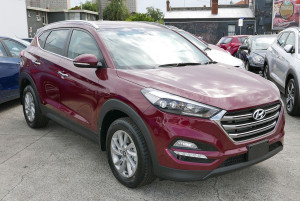 2016, 2017, 2018 Hyundai Tucson (TL)
2016, 2017, 2018 Hyundai Tucson (TL)
Guaranteed 3 across installations:
Clek Fllo (x3).
Clek Foonf (x3).
Diono Radian RXT (x3).
Diono Radian R120 (x3).
Diono Radian R100 (x3).
Chicco KeyFit 30 (x3).
Combi Coccoro (x3).
Clek Fllo, Diono Radian / RXT, Diono Radian / RXT.
Clek Fllo, Graco Size4Me 65, Diono Radian / RXT.
Chicco KeyFit 30, Clek Fllo, Chicco KeyFit 30.
Tips and Tricks:
The current generation of the Hyundai Tucson is just over 176 inches long and just under 73 inches wide, making it the largest generation of the Tucson yet. However, it’s still not going to be the easiest vehicle to work with when it comes to 3 across installations, although it’s definitely still possible with the right seats. The bigger challenge is likely to be the front-to-back space; because of how short the Tucson is, you’ll have to choose seats carefully to have an adequate amount of leg room left over in the front row if you’re planning on rear-facing your little ones.
I’d recommend checking out the space-saving convertible comparison guide to compare seats you might already have to the ones on this list. If you’re looking for my recommendations, I’d strongly suggest Radians due to the minimal amount of space they take up with angle adjusters; your legs and front-row passengers will thank you. Of course, be sure to use your seat belts instead of LATCH to make the most of your side-to-side space.
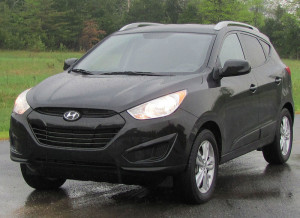 2010, 2011, 2012, 2013, 2014, 2015 Hyundai Tucson (LM)
2010, 2011, 2012, 2013, 2014, 2015 Hyundai Tucson (LM)
Guaranteed 3 across installations:
Clek Fllo (x3).
Clek Foonf (x3).
Diono Radian RXT (x3).
Diono Radian R120 (x3).
Diono Radian R100 (x3).
Chicco KeyFit 30 (x3).
Combi Coccoro (x3).
Clek Fllo, Diono Radian / RXT, Diono Radian / RXT.
Clek Fllo, Graco Size4Me 65, Diono Radian / RXT.
Chicco KeyFit 30, Clek Fllo, Chicco KeyFit 30.
Tips and Tricks:
The 2010-2015 generation of the Hyundai Tucson is 174 inches long and just under 72 inches wide. The narrow width of the Tucson means you’re going to have your work cut out for you when it comes to 3 across installations, although it’s definitely still possible with the right seats. The bigger challenge is likely to be the front-to-back space; because of how short the Tucson is, you’ll have to choose seats carefully to have an adequate amount of leg room left over in the front row if you’re planning on rear-facing your little ones.
I’d recommend checking out the space-saving convertible comparison guide to compare seats you might already have to the ones on this list. If you’re looking for my recommendations, I’d strongly suggest Radians due to the minimal amount of space they take up with angle adjusters; your legs and front-row passengers will thank you. Of course, be sure to use your seat belts instead of LATCH to make the most of your side-to-side space.
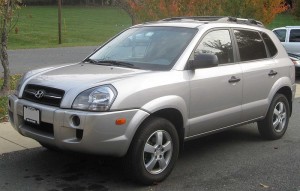 2005, 2006, 2007, 2008, 2009 Hyundai Tucson
2005, 2006, 2007, 2008, 2009 Hyundai Tucson
Guaranteed 3 across installations:
Clek Fllo (x3).
Clek Foonf (x3).
Diono Radian RXT (x3).
Diono Radian R120 (x3).
Diono Radian R100 (x3).
Combi Coccoro (x3).
Clek Fllo, Diono Radian / RXT, Diono Radian / RXT.
Tips and Tricks:
The initial generation of the Hyundai Tucson is 170 inches long and 71-72 inches wide. The narrow width of the Tucson means that once again, you’re going to have your work cut out for you when it comes to 3 across installations, although it’s definitely still possible with the right seats. As in the following generation, the bigger challenge is likely to be the front-to-back space; because of how short the Tucson is, you’ll have to choose seats carefully to have an adequate amount of leg room left over in the front row if you’re planning on rear-facing your little ones.
Once again, I’d recommend checking out the space-saving convertible comparison guide to compare seats you might already have to the ones on this list. If you’re looking for my recommendations, I’d strongly suggest Radians due to the minimal amount of space they take up with angle adjusters; your legs and front-row passengers will thank you. Of course, be sure to use your seat belts instead of LATCH to make the most of your side-to-side space.
—
If you find the information on car safety, recommended car seats, and car seat reviews on this car seat blog helpful, you can shop through this Amazon link for any purchases, car seat-related or not. Canadians can shop through this link for Canadian purchases.
Side Impact Crash Protection: The Safest Small SUVs and Crossovers in 2016
I’ve spent a lot of time recently writing about how dangerous side impact collisions can be, and how to keep our loved ones alive if we’re unfortunate enough to be involved in them. First I described the safest cars of 2015 per IIHS side impact intrusion metrics. Next I wrote an article describing the safest minivans available in 2015 for surviving t-bones based on the same metric. I then set to work to write the equivalent article on surviving side impacts in SUVs made in 2015. Most recently, I wrote about how to survive side impact collisions in small cars made in 2015. Today’s article is the latest in the series, and brings the focus to small SUVs and crossovers currently on the road.
To put it simply, side impact collisions are the collisions that are most likely to take your life or the life of a loved one, when compared with front-, and rear-end collisions. From doing the math in an earlier post on side impact collisions, we know that even though only around 1 out of every 5 collisions involve side impacts, they lead to 1 out of every 3 vehicle occupant deaths in multiple vehicle collisions. In comparison, basically 1 out of 2 collisions involve frontal impacts, which lead to around 1 out of every 2 multiple collision deaths. Even more dramatically, while more than 1 out of every 4 collisions are rear enders, they only result in around 1 out of every 12 multiple collision deaths.
Looking at the numbers shows us side impacts are the collisions most likely to be fatal, even though they’re the least common. Knowing this, it’s worth figuring out how to reduce our risks of dying from one.
How to keep from dying in a side impact collision – what options do we have?
Unfortunately, if you live in the United States, you live in a country that isn’t the most willing to make changes to make our roads safer for everyone. In the US, you can drink much, much more before you’re considered drunk than you would in many parts of Europe (where the driver death rates are lower). Similarly, you don’t really have restrictions on how big your vehicle can be, regardless of how little experience you have as a driver. This isn’t the case in a number of other countries. You also live in a country that turns a blind eye toward many speed limits and is vehemently opposed to traffic cameras, despite their prevalence in countries with lower crash death rates. And of course, you’re also in a country where it’s hard to travel long (or short) distances inexpensively without driving.
I’ve written about some of these issues in past articles, such as one on why Swedish roads are among the safest in the world, and another on why driving in Europe is safer than driving in the US. I’ll have more articles soon about the things we can learn from other countries when it comes to driving safely.
However, until we’re willing to make a number of necessary changes, if you’re invested in keeping your family safe from death in t-bone collisions, I’d recommend you:
1.) Avoid driving (e.g., by using public transportation or by cycling or walking…eventually this leads to a critical mass where everyone is safer).
2.) Limit driving (by the same measures above and by combining trips).
3.) Drive the most side-impact-resistant vehicles possible.
Ultimately, to truly bring an end to side impact collisions, as well as to all collisions, we’re going to need to be forced to invest in the first two measures. I’d consider self-driving or autonomous vehicles to be part of “avoiding driving,” even though those aren’t going to eliminate collisions completely until the vast majority of vehicles on the road are no longer being driven by humans (the critical mass argument).
However, unless you’re in a position to completely follow step 1, you’ll need to focus on 2 and 3. Step 2 isn’t always feasible either, so this post focuses on Step 3, and deals specifically with choosing the safest small SUVs and crossovers available for side impact protection in the US in 2016. I’ve written about the best cars for surviving side impacts, the best small cars for surviving small impacts, the best minivans for surviving small impacts, and the best SUVs and crossovers for surviving small impacts, all for 2015 models. It’s time to focus on 2016 models, since the technology is always improving, and unfortunately, these crashes aren’t going away–not yet, anyway.
Calculating which small SUVs and crossovers are the safest for side impact collisions by structural integrity (crush distance)
I’ve written about the math behind these calculations in previous posts, such as in the relevant articles on surviving side impacts in 2015 cars, minivans, and SUVs and crossovers, so hop back to those articles to read about this in detail. The short version is that the IIHS runs a side impact test. It simulates a 3300 lb SUV crashing into the side of a vehicle at 31 mph, or 143.7KJ of kinetic energy. Every vehicle deforms somewhat at the B-pillar when absorbing such an impact, and there’s a subscore in the IIHS test known as the “structure and safety cage” looks into how close the B-pillar intrudes into the center of the driver’s seat during the collision. Less intrusion is better. Let’s see who has the least intrusion right now in the small SUV market.
I searched through the test scores of every small (compact) or mini (subcompact) SUV or crossover currently available in the US to make this best-of list. Keep in mind that the IIHS continually updates their side impact information while gathering additional information, so in a few months, it’s likely that these numbers may be slightly different. All data is accurate as of late October 2015, and all images are either from yours truly or courtesy of Wikipedia.
The safest small SUVs and crossovers for side impact collisions in 2016
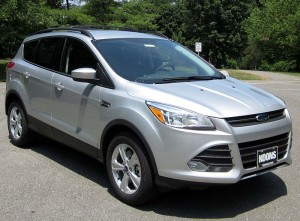 19.5 cm – 2013-2016 Ford Escape.
19.5 cm – 2013-2016 Ford Escape.
The current generation Ford Escape at 19.5 cm of intrusion protection was the highest-ranked small SUV in the overall 2015 SUV comparison, and it retains the title in 2016. The current Escape is a great improvement over the previous Escape, which only featured between 5.5 and 7.5 cm of intrusion protection. However, the current gen Escape still has a poor small overlap crash score, and is one of only a handful of vehicles on this list to do so. Ford can and needs to do better here, as more and more vehicles are acing the small overlap test, and the Escape is standing out in a bad way.
The ’09-’11 model years of the previous generation were estimated in the most recent driver death rate survey to have had DDRs of 27 and 35 in the 2WD and 4WD models respectively.
My full 3 across car seat guide to the Escape is available here.
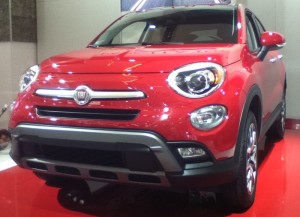 19 cm – 2016 Fiat 500X.
19 cm – 2016 Fiat 500X.
Hot on the heels of the Escape with 19 cm of impact resistance is the newly released Fiat 500X. It shares the same platform with the newly released Jeep Renegade and Fiat 500L, and is essentially a slightly Europeanized version of the Renegade. Fiat Chrysler Automobiles also scored a safety hit with the Fiat 500L, which was the most impact-resistant small car of 2015, and the Dodge Dart, which was the second best small car in 2015 for impact resistance. Unlike the 500L and Ford Escape, however, the 500X features a good small overlap score in addition to good scores in all other areas tested by the IIHS.
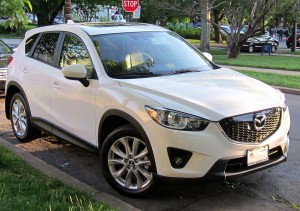 18.5 cm – 2013-2016 Mazda CX-5.
18.5 cm – 2013-2016 Mazda CX-5.
Immediately after the Fiat comes the current generation Mazda CX-5. Once again, unlike the Escape, it has a good small overlap score, and has had one since the ’14 model year. As with several other vehicles on this list, I look forward to seeing the CX-5 show up on a driver death rate study; Mazda will need to sell more of them for it to make an appearance.
My full 3 across car seat guide to the CX-5 is available here.
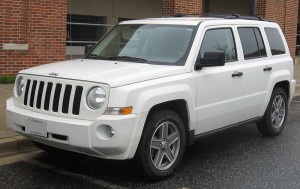 16.5 cm – 2014-2015 Jeep Patriot / Jeep Compass.
16.5 cm – 2014-2015 Jeep Patriot / Jeep Compass.
I have to admit that I almost forgot to include the Jeep Patriot or its curvy twin, the Compass. Both suffer from poor small overlap scores and are also among the only vehicles on the list to have no form of front crash prevention equipment whatsoever. However, with 16.5 cm of side impact resistance, both stand out in a good way, at least in this measure. These are also the second and third vehicles, respectively, by Fiat Chrysler Automobiles to make this list. The ’14 refresh of the Patriot / Compass also brought badly-needed side torso airbags to the front passenger seats; stay away from older years than 2014 if you’re considering used Patriots and Compasses.
The ’08-’11 model years of this generation were estimated in the most recent driver death rate survey to have had a DDRs of 7 for the 2WD Compass, and 11 and 57 for the 4WD and 2WD Patriots, respectively.
My full 3 across car seat guide to the Patriot is available here, while my Compass guide is available here.
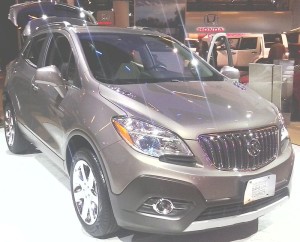 15.5 cm – 2013-2016 Buick Encore / Chevrolet Trax.
15.5 cm – 2013-2016 Buick Encore / Chevrolet Trax.
The Buick Encore and its twin, the Chevrolet Trax, are recent debuts in the small SUV / crossover market, but have already shown themselves to be strong contenders with 15.5 cm of side impact intrusion resistance. Once again, both feature good small overlap scores, and are among the first GM vehicles to show up on any of the impact resistance lists I’ve written so far.
You can read my full 3 across guide to the Encore / Trax here.
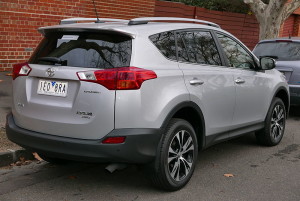 14.5-15 cm — 2013-2016 Toyota Rav4.
14.5-15 cm — 2013-2016 Toyota Rav4.
The Rav4 makes its first appearance in a positive light on this blog with the strong showing in 14.5-15 cm of side impact intrusion resistance. After being plagued with a poor small overlap score for years, Toyota finally addressed this in models built after November 2014, and now the Rav4 joins the ranks of small SUVs and crossovers with a good small overlap score.
Unfortunately, it still suffers from the overlapping seat belt issue; hopefully Toyota will address this soon, as it significantly limits the utility of this sport utility vehicle. For now, however, we can celebrate the improved small overlap score and the improvement in intrusion resistance over the previous generation, which featured only 7 cm of intrusion resistance. The ’08-’11 model years of that generation were estimated in the most recent driver death rate survey to have had DDRs of 19 and 35 in the 4WD and 2WD editions respectively.
My full 3 across car seat guide to the Rav4 is available here.
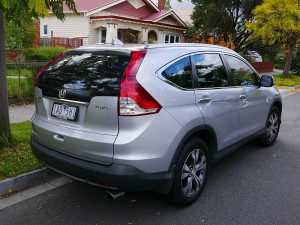 14 cm – 2015-2016 Honda CR-V.
14 cm – 2015-2016 Honda CR-V.
The CR-V has long been one of my favorite small SUVs due to its rock solid reliability, but until recently, it had been dogged by a marginal small overlap score. Honda finally addressed this in 2015, and now the CR-V joins the ranks of small crossovers with good scores up and down the board.
Featuring 14.5 cm of impact intrusion resistance, it remains competitive with some of the best small crossovers on the market today, although the current generation’s resistance is nearly identical to that of the previous generation at 13 cm. The ’08-’11 model years of that generation were estimated in the most recent driver death rate survey to have had DDRs of 17 and 19 in the 4WD and 2WD editions respectively.
My full 3 across car seat guide to the CR-V is available here.
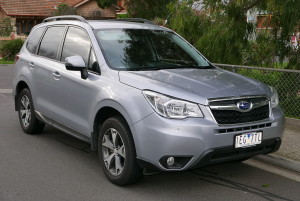 14 cm – 2014-2016 Subaru Forester.
14 cm – 2014-2016 Subaru Forester.
Tied with the CR-V at 14 cm is the Forester from Subaru. Like most of the vehicles on this list, it features a good small overlap score from 2014 onward, as well as good scores in every other area. The 14 cm is an improvement over the 11.5 cm of the previous generation Forester. The ’09-’11 model years of that generation were estimated in the most recent driver death rate survey to have had a DDR of 20.
My full 3 across car seat guide to the Forester is available here.
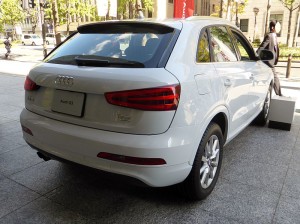 14 cm – 2015-2016 Audi Q3.
14 cm – 2015-2016 Audi Q3.
Finally, the Audi Q3 completes a 3-way tie with the Forester and CR-V at 14 cm of side impact intrusion resistance. The Q3 is a new entry from Audi, introduced in 2014 as a smaller counterpart to the mid-sized Q5, which itself is a smaller version of their Q7. Like nearly all vehicles on this list, it has good crash test scores, including a good small overlap score.
More broadly, once again, I have to give Fiat Chrysler Automobiles credit for making three of the most intrusion-resistant small SUVs available in the US market today in the Fiat 500X, Jeep Patriot, and Jeep Compass. They dominate this list the way they dominated the small car side impact resistance list of 2015, which they dominated the same way Volvo, Ford and Mercedes-Benz dominated the SUV/crossover list and Subaru, Fiat Chrysler Automobiles, and Mercedes-Benz dominated the overall car list. If you’re looking for safe vehicles, these are the manufacturers to pay attention to right now.
How to choose a small SUV or crossover to keep your loved ones safe in side impact crashes
In conclusion, the market for safe small SUVs keeps getting better every day in the United States. There are several compact crossovers that came within a fraction of a centimeter of making the list, but which I did not include in order to keep the list at the best of the best. The 2014-2016 Nissan Rogue, for example, featured 13.5 cm of intrusion resistance.
As in the other lists I’ve written, one of the overriding lessons is to consider the subscore for structural integrity rather than just stopping at the “good” overall side impact score. Small numbers can make a big difference in a high speed collision, and much as with an unbuckled seat belt, we don’t get the chance to change our minds in which vehicle we’ve chosen in the instant before a collision.
We can’t control everything. The safest option is still not driving at all, followed by driving as little as possible. But if you’ve got to drive, drive safely, and do your best to choose a safe vehicle. If you’re going to use it with children, definitely check out the plethora of best practice articles I’ve written here on choosing safe car seats, installation tips, seat reviews, and more information to help you make informed decisions.
I loved writing this article, and I hope you enjoyed reading it. I look forward to writing more articles examining various factors in car safety design and how they relate to keeping you and your loved ones safer while on the road. Stay tuned, remember to avoid common mistakes parents make with car seats, and check out some 3 across car seat guides while you’re here.
If you find the information on car safety, recommended car seats, and car seat reviews on this car seat blog helpful, you can shop through this Amazon link for any purchases, car seat-related or not. Canadians can shop through this link for Canadian purchases.
3 Across Installations: Which Car Seats Fit a Nissan Murano?
The Nissan Murano is the smaller of two mid-sized crossovers currently sold by Nissan in the US (the other being the larger 3-row-capable Pathfinder). The Murano competes with a bevy of mid-sized 2-row non-luxury SUVs available today, including the Ford Edge, Dodge Journey, Kia Sorento, Hyundai Santa Fe, Chevrolet Equinox, GMC Terrain, Jeep Cherokee, and Jeep Grand Cherokee. In the Nissan crossover / SUV family, it slots in above the smaller Nissan Rogue.
Like most of the competition, the latest Murano is outfitted with a range of modern safety features, including good small overlap and moderate overlap crash scores, good side and roof scores, and front crash prevention systems in optional trim levels. In other words, it’s a safe, family-capable SUV frequently chosen by parents interested in safe transportation for their children. But how does it do when it comes to providing room for 3 car seats of varying sizes across the back row? That’s what I set to find out.
Before looking at which car seats did and didn’t fit in the Murano in 3 across setups, it’s worth reviewing a bit of car safety, in terms of which kinds of seats to use and when.
Car seat safety starts with rear-facing. It’s the safest position we know of, and the longer our kids rear-face, the safer they’ll be, regardless of what kind of vehicle they travel in. I recommend keeping children in rear-facing infant or convertible seats as long as possible (ideally until 4!), then keeping them harnessed in forward-facing seats for several years more (ideally until 8!), and then only switching them out of booster seats when they pass the 5 step test (which typically happens between 10 and 12). The goal is to keep kids in the safest kinds of seats for as long as possible to increase their odds of surviving serious car crashes.
With that all in mind, I got to work with my seats to create what I believe to be the most detailed 3 across guide for the Nissan Murano on the Internet, covering every model year of the SUV so far. If you find the list helpful when shopping for car seats, you can shop through my Amazon link below. I’ll add more seats as I test them over time.
You can access the complete 3 across guide for every vehicle here and the complete list of recommended seats here. The Canadian car seat guide is here. 3 across car seat images are taken by yours truly or are courtesy of Wikipedia.
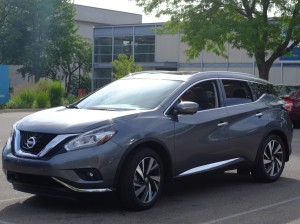 2015, 2016 Nissan Murano
2015, 2016 Nissan Murano
Guaranteed 3 across installations:
Clek Fllo (x3).
Clek Foonf (x3).
Diono Radian RXT (x3).
Diono Radian R120 (x3).
Diono Radian R100 (x3).
Graco Size4Me 65 (x3).
Graco Contender (x3).
Combi Coccoro (x3).
Tips and Tricks:
The current generation of the Nissan Murano is 192 inches long and 75 inches wide, making it both the longest and widest version of the Murano yet inside and out. As a result, it’s also the most car seat friendly version of the Murano, and 3 across setups with most normally-sized seats shouldn’t be an issue as long as you’re willing to use seat belts instead of the LATCH system. Remember that seat belts are as safe as LATCH, and in some cases, safer, depending on the weight limits of your car seats.
Given the length of the Murano, I wouldn’t expect you to have much trouble with fitting most seats in rear-facing configurations in terms of front-to-back space, but if you’re concerned about making things work, you can also check out my front-to-back comparison chart for rear-facing convertibles.
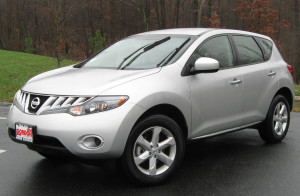 2009, 2010, 2011, 2012, 2013, 2014 Nissan Murano (Z51)
2009, 2010, 2011, 2012, 2013, 2014 Nissan Murano (Z51)
Guaranteed 3 across installations:
Clek Fllo (x3).
Clek Foonf (x3).
Diono Radian RXT (x3).
Diono Radian R120 (x3).
Diono Radian R100 (x3).
Graco Size4Me 65 (x3).
Graco Contender (x3).
Combi Coccoro (x3).
Chicco KeyFit 30, Diono Radian / RXT, Chicco KeyFit 30.
Tips and Tricks:
The 2009-2014 generation of the Nissan Murano is 189-190 inches long, depending on whether you purchased it before 2011 or after 2010 and 74 inches wide across all years of the generation. In other words, it’s quite close in size to the succeeding generation, although an inch narrower and a few inches shorter.
What this means is that you’ll still be able to fit a wide range of normal-sized car seats in it without much trouble as long as you use your seat belts. You can use LATCH if you’re aiming for just 2 across configurations, and it will work with a few, but not all 3 across combinations, especially if you’re trying to make things work with wider seats.
Given the length of the Murano, I wouldn’t expect you to have much trouble with fitting most seats in rear-facing configurations in terms of front-to-back space, but if you’re concerned about making things work, you can also check out my front-to-back comparison chart for rear-facing convertibles.
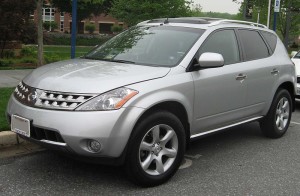 2003, 2004, 2005, 2006, 2007 Nissan Murano (Z50)
2003, 2004, 2005, 2006, 2007 Nissan Murano (Z50)
Guaranteed 3 across installations:
Clek Fllo (x3).
Clek Foonf (x3).
Diono Radian RXT (x3).
Diono Radian R120 (x3).
Diono Radian R100 (x3).
Graco Size4Me 65 (x3).
Graco Contender (x3).
Combi Coccoro (x3).
Chicco KeyFit 30, Diono Radian / RXT, Chicco KeyFit 30.
Tips and Tricks:
The 2003-2007 initial generation of the Nissan Murano is 188 inches long and 74 inches wide across all years of the generation. In other words, it’s quite close in size to the succeeding generation, although a few inches shorter.
What this means is that you’ll still be able to fit a wide range of normal-sized car seats in it without much trouble as long as you use your seat belts. You can use LATCH if you’re aiming for just 2 across configurations, and it will work with a few, but not all 3 across combinations, especially if you’re trying to make things work with wider seats.
Given the length of the Murano, I wouldn’t expect you to have much trouble with fitting most seats in rear-facing configurations in terms of front-to-back space, but if you’re concerned about making things work, you can also check out my front-to-back comparison chart for rear-facing convertibles.
—
If you find the information on car safety, recommended car seats, and car seat reviews on this car seat blog helpful, you can shop through this Amazon link for any purchases, car seat-related or not. Canadians can shop through this link for Canadian purchases.

